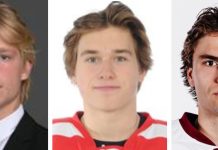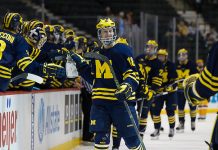In the comments section of last week’s Hobey Watch, one USCHO reader seemed to take great offense at the fact that my blog entry contained no mention of Minnesota forward Nick Bjugstad, as if I’d never heard of him.
For what it’s worth, this is the same Nick Bjugstad whom I (incorrectly) predicted as one of the top 10 Hobey Baker Award finalists last year, not to mention a highly touted Florida Panthers prospect who was mentioned prominently over the summer as a possible candidate to be part of a trade for Roberto Luongo, so yeah … I’ve heard of the guy.
Nonetheless, I took the liberty of looking in on Minnesota’s game against Alaska-Anchorage on the Big Ten Network this past weekend in the hopes of getting a better look at Bjugstad and giving some thought to his spot in this Hobey race.
Bjugstad certainly delivered the goods in the televised game, scoring twice in the Gophers’ 4-3, come-from-behind win over the Seawolves. Moreover, his goals both came in crucial situations: a go-ahead goal in the second period with the score tied at 1-1 and the tying goal in the third period when Minnesota trailed the Seawolves 3-2.
However, what I was most impressed by was the holding penalty that Bjugstad was able to draw on Alaska-Anchorage’s Austin Coldwell, setting up the power play that yielded the Gophers’ first goal.
Make no mistake, it wasn’t a bad penalty by Coldwell. He was the only one who was in a position to stop Bjugstad, who had a clear path, from getting to the net for an excellent chance on UAA goalie Rob Gunderson. Bjugstad had done an excellent job winning a puck battle in the corner and curling toward the net, forcing the penalty.
It was that moment more than any other in the game (from what I saw) that illustrated just how dominant a player Bjugstad is for the Gophers, and why the 6-foot-6, 220-pounder has earned the moniker “The Beast,” from the BTN commentators if no one else. It makes me think of a song of the same name from the Fugees’ 1996 album The Score. Just to be clear, the song’s called “The Beast,” not “Nick Bjugstad,” which is understandable, since Bjugstad was 3½ when that album came out. Man, do I feel old!
(By the way, memo to the Minnesota Pep Band: That song’s hook — “Warn the town, the Beast is loose” — could be a nice quick tune to play between whistles, with the opportunity for some nice trumpet glissandos. OK, the music geekery portion of this blog post is over, back to hockey.)
In any case, there’s no denying that “The Beast” is a dominant force for the top-ranked Gophers, and it’s easy to understand why he was a first-round draft pick by the Panthers. The question, however, has little to do with his pro upside, and much more to do with his numbers.
In a Hobey Watch blog post last year, I pointed out that every forward to win the Hobey in the last decade has been one of the top 15 scorers in the nation, in terms of points per game. Actually, 13th is the lowest position on the scoring chart for a Hobey-winning forward in that time frame — Wisconsin’s Blake Geoffrion in 2010 — but I think top 15 seems like an accurate estimate of that particular criterion. Bjugstad, with 12 goals and 10 assists in 22 games, is tied for 34th in the country as of this writing. Unless this year’s Hobey committee evaluates candidates in a far different manner than previous committees have — or unless Bjugstad goes on a huge scoring run in the second half of the season — I do not see Nick Bjugstad winning the Hobey this year.
That’s not a knock on Bjugstad, not in the least. I think his play should get him a finalist spot at the very least, particularly since that’s the portion of the voting that is done by the nation’s coaches (the selection committee of coaches, media members, scouts and officials votes on the winner from the 10 finalists). However, based on the way Hobey voting seems to go, Bjugstad, as it stands today, does not have the mark of a Hobey winner.
Again, there’s nothing wrong with that. It’s just how the Hobey works. As the Gophers prepare to face North Dakota this weekend, it’s worth remembering that the last UND player to win the Hobey, Ryan Duncan, has proven to be the third-best player on his own line from that year. However, at the end of the day, Duncan had 31 goals that year as part of his 57 points, compared to 18 goals and 46 points for Jonathan Toews and 17 goals and 52 points for T.J. Oshie. (Also, if T.J. Hensick hadn’t gotten himself tossed from the Michigan-North Dakota game in the regionals, we might not even be talking about Duncan’s Hobey-worthiness, but that’s a whole other messy story.)
For years, the shorthand for the Hobey Baker Award has been that it’s the Heisman Trophy of college hockey. If that’s the case, then we have to keep in mind that the Heisman has had its fair share of players that don’t go on to pro stardom. They have their Barry Sanders, Marcus Allen and Bo Jackson, but they also have their Danny Wuerffel, Troy Smith and Jason White. By the same token, we have our Ryan Miller, Chris Drury and Paul Kariya, but we also have the guys who didn’t really make it in the NHL. There’s nothing wrong with that, because it’s an award for college hockey players, not an award for pro prospects.
So, that brings us back to Bjugstad. He may wind up going on to have a better pro career than whoever wins this year’s Hobey (although if it is John Gaudreau, I think that he certainly has the Calgary Flames salivating). But based on the numbers, I don’t see Bjugstad as a true Hobey contender at this point in time.
Of course, I could be wrong, and I’m sure that I’ll hear about it if I am.


